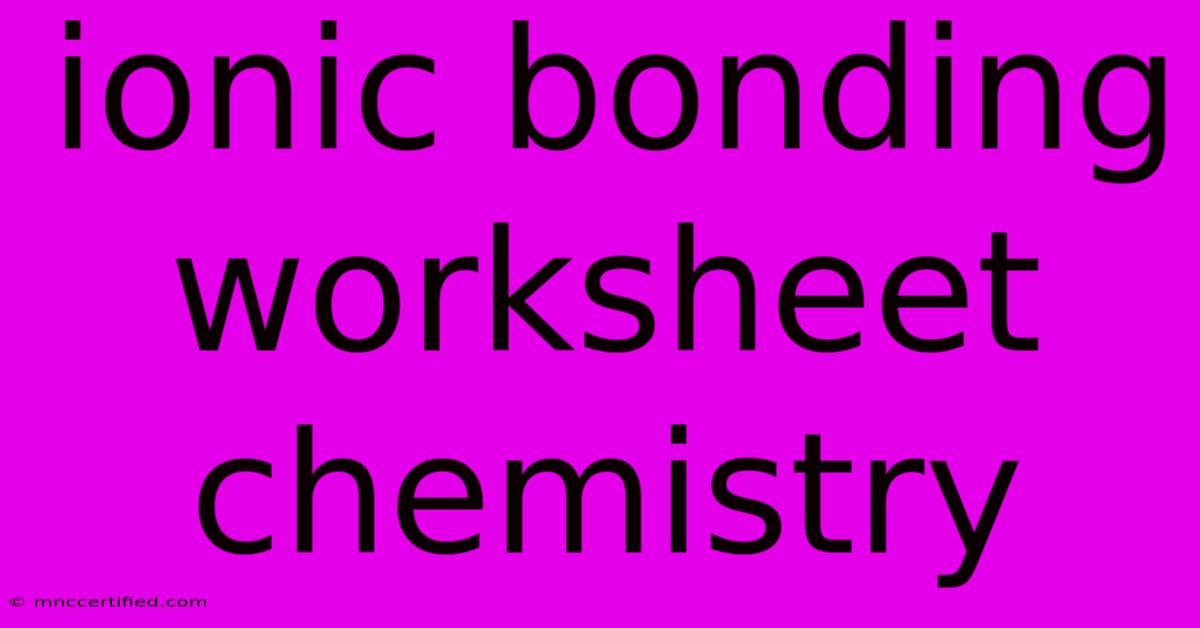Ionic Bonding Worksheet Chemistry

Table of Contents
Ionic Bonding Worksheet: A Comprehensive Guide for Chemistry Students
Ionic bonding is a fundamental concept in chemistry, and mastering it is crucial for success in the subject. This article provides a comprehensive guide to ionic bonding, complete with practice exercises and solutions to help you solidify your understanding. We’ll cover everything from the basics of electron transfer to predicting the formulas of ionic compounds. This guide is designed to be used alongside your ionic bonding worksheet, helping you understand the concepts and apply them effectively.
Understanding Ionic Bonds: The Basics
Ionic bonding occurs when atoms transfer electrons to achieve a stable electron configuration, typically a full outer electron shell (octet rule). This transfer creates ions: cations (positively charged ions) and anions (negatively charged ions). The electrostatic attraction between these oppositely charged ions forms the ionic bond.
Key Concepts to Remember:
- Electronegativity: The ability of an atom to attract electrons in a chemical bond. A large difference in electronegativity between atoms is essential for ionic bonding to occur.
- Metals and Nonmetals: Ionic bonds typically form between a metal (which readily loses electrons) and a nonmetal (which readily gains electrons).
- Octet Rule: Atoms tend to gain, lose, or share electrons to achieve eight electrons in their valence shell (outermost shell). There are exceptions, particularly for elements in the first and second periods.
Types of Ions: Cations and Anions
Understanding how ions are formed is critical.
- Cations: Formed when a metal atom loses one or more electrons. For example, sodium (Na) loses one electron to become Na⁺. Group 1 metals typically form +1 ions, Group 2 metals form +2 ions, and transition metals can form multiple cationic states (e.g., Fe²⁺ and Fe³⁺).
- Anions: Formed when a nonmetal atom gains one or more electrons. For example, chlorine (Cl) gains one electron to become Cl⁻. Group 17 (halogens) typically form -1 ions, Group 16 elements often form -2 ions, and so on.
Predicting Ionic Formulas: A Step-by-Step Approach
Predicting the formula of an ionic compound involves balancing the charges of the cation and anion to achieve electrical neutrality. Here's a step-by-step guide:
- Identify the ions: Determine the charges of the cation and anion involved.
- Balance the charges: Use the criss-cross method: the magnitude of the cation's charge becomes the subscript of the anion, and vice-versa.
- Simplify the formula: Reduce the subscripts to the smallest whole-number ratio.
Example: Forming the formula for sodium chloride (NaCl)
- Sodium (Na) forms a +1 ion (Na⁺).
- Chlorine (Cl) forms a -1 ion (Cl⁻).
- Using the criss-cross method, the formula becomes NaCl (the charges cancel each other out).
Example: Forming the formula for Magnesium Oxide (MgO)
- Magnesium (Mg) forms a +2 ion (Mg²⁺).
- Oxygen (O) forms a -2 ion (O²⁻).
- Using the criss-cross method, we get Mg₂O₂. Simplifying, we get MgO.
Ionic Bonding Worksheet Practice Problems
Let’s put your knowledge to the test with some practice problems. Try to answer these questions, referring back to the concepts covered above:
- What is the ionic formula for calcium chloride?
- What is the charge of the aluminum ion (Al)?
- Explain why ionic compounds have high melting points.
- Predict the formula for the ionic compound formed between potassium and sulfur.
- Which elements tend to form ionic compounds?
(Solutions are provided at the end of the article.)
Further Exploration: Properties of Ionic Compounds
Ionic compounds exhibit specific properties due to the strong electrostatic forces between the ions:
- High melting and boiling points: Strong attractive forces require significant energy to overcome.
- Crystalline structure: Ions are arranged in a regular, repeating pattern.
- Conduct electricity when molten or dissolved in water: Free-moving ions can carry an electric current.
- Brittle: Disruption of the crystal lattice leads to repulsion between like charges.
Off-Page SEO Strategies for Increased Visibility
To improve the visibility of this article, consider the following off-page SEO strategies:
- Guest blogging: Write articles about ionic bonding for other chemistry-related websites.
- Social media promotion: Share your article on relevant platforms.
- Forum participation: Engage in online chemistry forums and answer questions related to ionic bonding.
- Link building: Acquire backlinks from reputable chemistry websites.
Solutions to Practice Problems
- Calcium Chloride: CaCl₂
- Aluminum Ion: Al³⁺
- High Melting Points: Due to the strong electrostatic attractions between oppositely charged ions.
- Potassium and Sulfur: K₂S
- Ionic Compounds: Typically formed between metals and nonmetals.
This comprehensive guide provides a strong foundation for understanding ionic bonding. Remember to practice regularly and use your ionic bonding worksheet to reinforce your learning. Good luck!

Thank you for visiting our website wich cover about Ionic Bonding Worksheet Chemistry. We hope the information provided has been useful to you. Feel free to contact us if you have any questions or need further assistance. See you next time and dont miss to bookmark.
Featured Posts
-
Live Blog Wales V Australia Rugby Match
Nov 18, 2024
-
Harambe Ai Token Price Prediction
Nov 18, 2024
-
Glastonbury Tickets A 35 Minute Frenzy
Nov 18, 2024
-
England Vs Ireland Live Nations League Result
Nov 18, 2024
-
Dawand Jones Season Ending Leg Injury
Nov 18, 2024